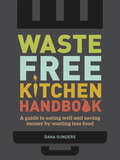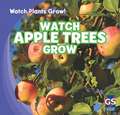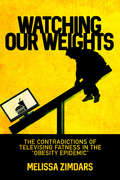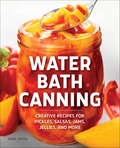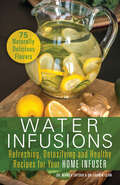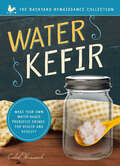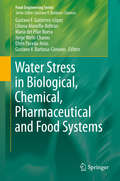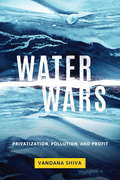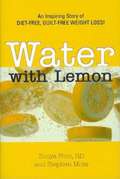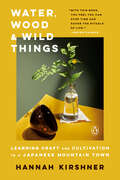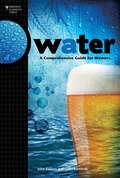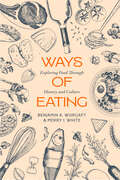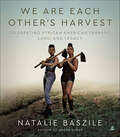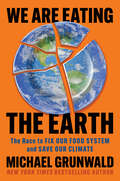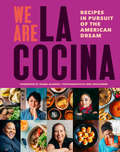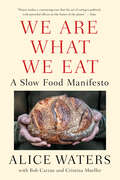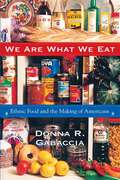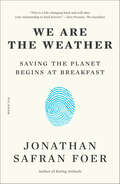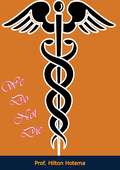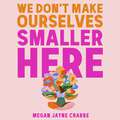- Table View
- List View
Waste-Free Kitchen Handbook: A Guide to Eating Well and Saving Money By Wasting Less Food
by Dana GundersThis &“slim but indispensable new guide&” offers &“practical tips and delicious recipes that will help reduce kitchen waste and save money&” (The Washington Post). Despite a growing awareness of food waste, many well-intentioned home cooks lack the tools to change their habits. This handbook—packed with engaging checklists, simple recipes, practical strategies, and educational infographics—is the ultimate tool for using more and wasting less in your kitchen. From a scientist at the Natural Resources Defense Council come these everyday techniques that call for minimal adjustments of habit, from shopping, portioning, and using a refrigerator properly to simple preservation methods including freezing, pickling, and cellaring. At once a good read and a go-to reference, this handy guide is chock-full of helpful facts and tips, including twenty &“use-it-up&” recipes and a substantial directory of common foods.
Wastelands: The True Story of Farm Country on Trial
by Corban Addison"Beautifully written, impeccably researched, and told with the air of suspense that few writers can handle, Wastelands is a story I wish I had written." —From the Foreword by John Grisham The once idyllic coastal plain of North Carolina is home to a close-knit, rural community that for more than a generation has battled the polluting practices of large-scale farming taking place in its own backyard. After years of frustration and futility, an impassioned cadre of local residents, led by a team of intrepid and dedicated lawyers, filed a lawsuit against one of the world&’s most powerful companies—and, miraculously, they won. As vivid and fast-paced as a thriller, Wastelands takes us into the heart of a legal battle over the future of America&’s farmland and into the lives of the people who found the courage to fight.There is Elsie Herring, the most outspoken of the neighbors, who has endured racial slurs and the threat of a restraining order to tell the story of the waste raining down on her rooftop from the hog operation next door. There is Don Webb, a larger-than-life hog farmer turned grassroots crusader, and Rick Dove, a riverkeeper and erstwhile military judge who has pioneered the use of aerial photography to document the scale of the pollution. There is Woodell McGowan, a quiet man whose quest to redeem his family&’s ancestral land encourages him to become a better neighbor, and Dr. Steve Wing, a groundbreaking epidemiologist whose work on the health effects of hog waste exposure translates the neighbors&’ stories into the argot of science. And there is Tom Butler, an environmental savant and hog industry insider whose whistleblowing testimony electrifies the jury.Fighting alongside them in the courtroom is Mona Lisa Wallace, who broke the gender barrier in her small southern town and built a storied legal career out of vanquishing corporate giants, and Mike Kaeske, whose trial skills are second to none. With journalistic rigor and a novelist&’s instinct for story, Corban Addison's Wastelands captures the inspiring struggle to bring a modern-day monopoly to its knees, to force a once-invincible corporation to change, and to preserve the rights—and restore the heritage—of a long-suffering community.
Watch Apple Trees Grow (Watch Plants Grow)
by Mary Ann HoffmanApples aren't just good for keeping doctors at bay, they also make for a tasty snack. Readers will explore the life of apple trees from their beginnings as seeds to the fruit they produce. Colorful photographs show the growth of an apple tree in perfect detail. Readers even learn how bees play an important part in growing apples.
Watching Our Weights: The Contradictions of Televising Fatness in the “Obesity Epidemic”
by Melissa ZimdarsWatching Our Weights explores the competing and contradictory fat representations on television that are related to weight-loss and health, medicalization and disease, and body positivity and fat acceptance. While television—especially reality television—is typically understood to promote individual self-discipline and expert interventions as necessary for transforming fat bodies into thin bodies, fat representations and narratives on television also create space for alternative as well as resistant discourses of the body. Melissa Zimdars thus examines the resistance inherent within TV representations and narratives of fatness as a global health issue, the inherent and overt resistance found across stories of medicalized fatness, and programs that actively avoid dieting narratives in favor of less oppressive ways of thinking about the fat body. Watching Our Weights weaves together analyses of media industry lore and decisions, communication and health policies, medical research, activist projects, popular culture, and media texts to establish both how television shapes our knowledge of fatness and how fatness helps us better understand contemporary television.
Water Bath Canning: Creative Recipes for Pickles, Salsas, Jams, Jellies, and More
by Renee PottleOpen the lid on this classic canning technique with new recipes and exciting flavor combinations Water bath canning has been a traditional method for preserving fresh foods for centuries. This cookbook by author and canning guru, Renee Pottle, brings the canning tradition into the 21st century with modern flavors, unexpected ingredients, reimagined classics, and long-forgotten specialities.What sets this canning recipes cookbook apart from other canning and preserving books:Canning for beginners—Learn everything you need to start making delicious preserves, including updated canning processes to ensure your preserves are safe, how to tell if your jam has gelled, and what to do if something goes wrong.Stocking the canning kitchen—Discover the essential staples and must-have equipment you need to become a canning rock star, along with tips on scoring the best ingredients at your local grocery store or farmers market.Creative concoctions—Find recipes for 75 unique sauces, fillings, syrups, pickles, and more—enough to keep you happily canning throughout the harvest season and beyond.Fill your shelves and your belly with the delectable preserves from this indispensable canning cookbook.
Water Infusions: Refreshing, Detoxifying and Healthy Recipes for Your Home Infuser
by Mariza Snyder Lauren ClumDELICIOUSLY-FLAVORED AND VITAMIN-ENRICHED WATERS CONVENIENTLY MADE AT HOME IN INFUSION PITCHERS OR BOTTLESThe natural and convenient way to add organic flavor to your water, infusion pitchers and bottles make your water as great-tasting as it is great for you. But don't limit yourself to just lemon or cucumber-this book shows how easy it is to create a wide variety of uniquely delicious waters, including:REFRESHING: Cherry Lime Vanilla Spicy Lemon Jalapeño Cucumber BasilDETOXING: Cranberry Detox Sparkler Sublime Pineapple Flush Blueberry Skin RenewalHEALING: Berry Antioxidant Boost Mango Lime Immunity Blast Relaxing Herbal SipperYou know staying hydrated is vital for your body. But why ingest the artificial flavorings found in store-bought waters? With this book's recipes you can utilize seasonal fruits, vegetables and herbs to make the most flavorful, all-natural water you've ever tasted.us fruit and vegetable readers can use in their infusers while separating truth from myth on the importance of water in one's diet.
Water Kefir: Make Your Own Water-Based Probiotic Drinks for Health and Vitality (The Backyard Renaissance Series)
by Caleb WarnockCaleb Warnock, the author of the bestselling Backyard Renaissance Series, provides the most understandable and important look at the health benefits of water kefir to date. Using his decades of self-sufficiency experience, Caleb makes making kefir simple and easy enough for anyone to have success brewing their own water kefir. Includes: Water kefir grainsThe history of water kefirHealth benefitsSimple step-by-step instructionsRecipesFrequently asked questions
Water Stress in Biological, Chemical, Pharmaceutical and Food Systems
by Jorge Welti-Chanes Gustavo V. Barbosa-Cánovas Gustavo F. Gutiérrez-López Liliana Alamilla-Beltrán María del Pilar Buera Efrén Parada-AriasWater Stress Management contains the invited lectures and selected oral and poster presentations of the 11th International Symposium on the Properties of Water (ISOPOW), which was held in Queretaro, Mexico 5-9 September 2010. The text provides a holistic description and discussion of state-of-the-art topics on the role of water in Biological, Chemical, Pharmaceutical and Food systems within a frame of an integrated approach and future trends on the subject. Different points-of-view about the state of water and phase transitions in a variety of substrates are presented. ISOPOW is a non-profit scientific organization whose activities aim at progressing the understanding of the properties of water in food and related biological systems and the exploitation of this understanding in improved raw materials, products and processes in the food, agro food or related industries. The first Symposium was organized in Glasgow, Scotland in 1974. Since then, ISOPOW meetings have promoted the exchange of knowledge between scientists involved in the study of food materials and scientists interested in water from a more basic point of view and the dialogue between academic and industrial scientists/technologists.
Water Wars
by Vandana ShivaAcclaimed author and award-winning scientist and activist Vandana Shiva lucidly details the severity of the global water shortage, calling the water crisis "the most pervasive, most severe, and most invisible dimension of the ecological devastation of the earth." She sheds light on the activists who are fighting corporate maneuvers to convert the life-sustaining resource of water into more gold for the elites and uses her knowledge of science and society to outline the emergence of corporate culture and the historical erosion of communal water rights. Using the international water trade and industrial activities such as damming, mining, and aquafarming as her lens, Shiva exposes the destruction of the earth and the disenfranchisement of the world's poor as they are stripped of rights to a precious common good. Revealing how many of the most important conflicts of our time, most often camouflaged as ethnic wars or religious wars, are in fact conflicts over scarce but vital natural resources, she calls for a movement to preserve water access for all and offers a blueprint for global resistance based on examples of successful campaigns. Featuring a new introduction by the author, this edition of Water Wars celebrates the spiritual and traditional role water has played in communities throughout history and warns that water privatization threatens cultures and livelihoods worldwide.
Water With Lemon
by Stephen Moss Zonya FocoPower of One Good Habit Water with Lemon is the first health novel in the Power of One Good Habit series. Introducing A New Genre: The Health Novel 60 extra pounds. An unhappy marriage. Food for comfort. Karen's life is falling apart. Then she meets an unlikely neighbor who reveals how a series of simple choices have the power to shape the life we have - into the life we want. Karen's story of weight loss and personal transformation will touch your heart and open your eyes! It will reveal how eight powerful, core habits, when mastered one at a time, create an invisible force that will literally - change your life. What do you get when you cross a nutritionist with a novelist? A health novel! Where nutrition, health and weight-loss information are woven into the story. Each challenge the characters face not only teaches you what to do - it inspires you to actually do it. Zonya Foco, America's Nutrition Leader, and Stephen Moss, America's Health Novelist, have joined forces to create this exciting new genre. Stephen's compelling story will keep you turning the pages while Zonya's surprisingly simple approach to mastering weight control is revealed. You'll discover that this is not another fad diet book. In fact, it's not a diet book at all. There is no diet mentality. Nothing to calculate. And never a reason to feel guilty!
Water, Wood, and Wild Things: Learning Craft and Cultivation in a Japanese Mountain Town
by Hannah Kirshner"With this book, you feel you can stop time and savor the rituals of life." --Maira KalmanAn immersive journey through the culture and cuisine of one Japanese town, its forest, and its watershed--where ducks are hunted by net, saké is brewed from the purest mountain water, and charcoal is fired in stone kilns--by an American writer and food stylist who spent years working alongside artisansOne night, Brooklyn-based artist and food writer Hannah Kirshner received a life-changing invitation to apprentice with a "saké evangelist" in a misty Japanese mountain village called Yamanaka. In a rapidly modernizing Japan, the region--a stronghold of the country's old-fashioned ways--was quickly becoming a destination for chefs and artisans looking to learn about the traditions that have long shaped Japanese culture. Kirshner put on a vest and tie and took her place behind the saké bar. Before long, she met a community of craftspeople, farmers, and foragers--master woodturners, hunters, a paper artist, and a man making charcoal in his nearly abandoned village on the outskirts of town. Kirshner found each craftsperson not only exhibited an extraordinary dedication to their work but their distinct expertise contributed to the fabric of the local culture. Inspired by these masters, she devoted herself to learning how they work and live.Taking readers deep into evergreen forests, terraced rice fields, and smoke-filled workshops, Kirshner captures the centuries-old traditions still alive in Yamanaka. Water, Wood, and Wild Things invites readers to see what goes into making a fine bowl, a cup of tea, or a harvest of rice and introduces the masters who dedicate their lives to this work. Part travelogue, part meditation on the meaning of work, and full of her own beautiful drawings and recipes, Kirshner's refreshing book is an ode to a place and its people, as well as a profound examination of what it means to sustain traditions and find purpose in cultivation and craft.
Water: A Comprehensive Guide for Brewers (Brewing Elements)
by John J. Palmer Colin KaminskiWater is arguably the most critical and least understood of the foundation elements in brewing. For many brewers used to choosing from a wide selection of hops and grain, water seems like an ingredient for which they have little choice but to accept what comes out of their faucet. But brewers in fact have many opportunities to modify their source water or to obtain mineral-free water and build their own brewing water from scratch. Much of the relevant information can be found in texts on physical and inorganic chemistry or water treatment and analysis, but these resources seldom, if ever, speak to brewers.Water: A Comprehensive Guide for Brewers takes the mystery out of water's role in the brewing process. This book is not just about brewing liquor. Whether in a brewery or at home, water is needed for every part of the brewing process: chilling, diluting, cleaning, boiler operation, wastewater treatment, and even physically pushing wort or beer from one place to another. The authors lead the reader from an overview of the water cycle and water sources, to adjusting water for different beer styles and brewery processes, to wastewater treatment.It covers precipitation, groundwater, and surface water, and explains how municipal water is treated to make it safe to drink but not always suitable for brewing. The parameters measured in a water report are explained, along with their impact on the mash and the final beer. Understand ion concentrations, temporary and permanent hardness, and pH. The concept of residual alkalinity is covered in detail and the causes of alkalinity in water are explored, along with techniques to control alkalinity.Ultimately, residual alkalinity is the major effector on mash pH, and this book addresses how to predict and target a specific mash pH—a key skill for any brewer wishing to raise their beer to the next level. But minerals in brewing water also determine specific flavor attributes. Ionic species important to beer are discussed and concepts like the sulfate-to-chloride ratio are explained. Examples illustrate how to tailor your brewing water to suit any style of beer.To complete the subject, the authors focus on brewery operations relating to source water treatment, such as the removal of particulates, dissolved solids, gas and liquid contaminants, organic contaminants, chlorine and chloramine, and dissolved oxygen. This section considers the pros and cons of various technologies, including membrane technologies such as filtration, ion-exchange systems, and reverse osmosis.
Watercress
by Jason Chin Andrea WangCaldecott Medal Winner, Newbery Honor Book, APALA Award Winner <p><p>A story about the power of sharing memories—including the painful ones—and the way our heritage stays with and shapes us, even when we don’t see it. <p><p>While driving through Ohio in an old Pontiac, a young girl's Chinese immigrant parents spot watercress growing wild in a ditch by the side of the road. They stop the car, grabbing rusty scissors and an old paper bag, and the whole family wades into the mud to gather as much as they can. At first, she's embarrassed. Why can't her family just get food from the grocery store, like everyone else? But when her mother shares a bittersweet story of her family history in China, the girl learns to appreciate the fresh food they foraged—and the memories left behind in pursuit of a new life. <p><p>Together, they make a new memory of watercress. <p><p>Author Andrea Wang calls this moving, autobiographical story “both an apology and a love letter to my parents.” It’s a bittersweet, delicate look at how sharing the difficult parts of our histories can create powerful new moments of family history, and help connect us to our roots. Jason Chin’s illustrations move between China and the American Midwest and were created with a mixture of traditional Chinese brushes and western media. The dreamy, nostalgic color palette brings this beautiful story to life. An endnote from the author describes her personal connection to the story, and an illustrator’s note touches on both the process of the painting, and the emotional meaning brought to the work.
Watermelon and Red Birds: A Cookbook for Juneteenth and Black Celebrations
by Nicole A. TaylorThe very first cookbook to celebrate Juneteenth, from food writer and cookbook author Nicole A. Taylor—who draws on her decade of experiences observing the holiday.On June 19, 1865, more than two years after President Abraham Lincoln signed the Emancipation Proclamation, Major General Gordon Granger arrived in Galveston and issued General Order Number 3, informing the people of Texas that all enslaved people were now free. A year later, in 1866, Black Texans congregated with music, dance, and BBQs—Juneteenth celebrations. All-day cook-outs with artful salads, bounteous dessert spreads, and raised glasses of &“red drink&” are essential to Juneteenth gatherings. In Watermelon and Red Birds, Nicole puts jubilation on the main stage. As a master storyteller and cook, she bridges the traditional African-American table and 21st-century flavors in stories and recipes. Nicole synthesizes all the places we&’ve been, all the people we have come from, all the people we have become, and all the culinary ideas we have embraced. Watermelon and Red Birds contains over 75 recipes, including drinks like Afro Egg Cream and Marigold Gin Sour, dishes like Beef Ribs with Fermented Harissa Sauce, Peach Jam and Molasses Glazed Chicken Thighs, Southern-ish Potato Salad and Cantaloupe and Feta Salad, and desserts like Roasted Nectarine Sundae, and Radish and Ginger Pound Cake. Taylor also provides a resource to guide readers to BIPOC-owned hot sauces, jams, spice, and waffle mixes companies and lists fun gadgets to make your Juneteenth special. These recipes and essays will inspire parties to salute one of the most important American holidays, and moments to savor joy all year round.
Ways of Eating: Exploring Food through History and Culture (California Studies in Food and Culture #81)
by Merry White Benjamin Aldes WurgaftWhat we learn when an anthropologist and a historian talk about food. From the origins of agriculture to contemporary debates over culinary authenticity, Ways of Eating introduces readers to world food history and food anthropology. Through engaging stories and historical deep dives, Benjamin A. Wurgaft and Merry I. White offer new ways to understand food in relation to its natural and cultural histories and the social rules that shape our meals. Wurgaft and White use vivid storytelling to bring food practices to life, weaving stories of Panamanian coffee growers, medieval women beer makers, and Japanese knife forgers. From the Venetian spice trade to the Columbian Exchange, from Roman garum to Vietnamese nớc chấm, Ways of Eating provides an absorbing account of world food history and anthropology. Migration, politics, and the dynamics of group identity all shape what we eat, and we can learn to trace these social forces from the plate to the kitchen, the factory, and the field.
We Are Each Other's Harvest: Celebrating African American Farmers, Land, and Legacy
by Natalie BaszileA WALL STREET JOURNAL FAVORITE FOOD BOOK OF THE EARFrom the author of Queen Sugar—now a critically acclaimed series on OWN directed by Ava Duvernay—comes a beautiful exploration and celebration of black farming in America. In this impressive anthology, Natalie Baszile brings together essays, poems, photographs, quotes, conversations, and first-person stories to examine black people’s connection to the American land from Emancipation to today. In the 1920s, there were over one million black farmers; today there are just 45,000. Baszile explores this crisis, through the farmers’ personal experiences. In their own words, middle aged and elderly black farmers explain why they continue to farm despite systemic discrimination and land loss. The "Returning Generation"—young farmers, who are building upon the legacy of their ancestors, talk about the challenges they face as they seek to redress issues of food justice, food sovereignty, and reparations. These farmers are joined by other influential voices, including noted historians Analena Hope Hassberg and Pete Daniel, and award-winning author Clyde W. Ford, who considers the arrival of Africans to American shores; and James Beard Award-winning writers and Michael Twitty, reflects on black culinary tradition and its African roots. Poetry and inspirational quotes are woven into these diverse narratives, adding richness and texture, as well as stunning four-color photographs from photographers Alison Gootee and Malcom Williams, and Baszile’s personal collection. As Baszile reveals, black farming informs crucial aspects of American culture—the family, the way our national identity is bound up with the land, the pull of memory, the healing power of food, and race relations. She reminds us that the land, well-earned and fiercely protected, transcends history and signifies a home that can be tended, tilled, and passed to succeeding generations with pride. We Are Each Other’s Harvest elevates the voices and stories of black farmers and people of color, celebrating their perseverance and resilience, while spotlighting the challenges they continue to face. Luminous and eye-opening, this eclectic collection helps people and communities of color today reimagine what it means to be dedicated to the soil.
We Are Eating the Earth: The Race to Fix Our Food System and Save Our Climate
by Michael GrunwaldFrom the author of New York Times bestseller The New New Deal, a groundbreaking piece of reportage from the trenches of the next climate war: the fight to fix our food system.Humanity has cleared a land mass the size of Asia plus Europe to grow food, and our food system generates a third of our carbon emissions. By 2050, we&’re going to need a lot more calories to fill nearly 10 billion bellies, but we can&’t feed the world without frying it if we keep tearing down an acre of rainforest every six seconds. We are eating the earth, and the greatest challenge facing our species will be to slow our relentless expansion of farmland into nature. Even if we quit fossil fuels, we&’ll keep hurtling towards climate chaos if we don&’t solve our food and land problems. In this rollicking, shocking narrative, Grunwald shows how the world, after decades of ignoring the climate problem at the center of our plates, has pivoted to making it worse, embracing solutions that sound sustainable but could make it even harder to grow more food with less land. But he also tells the stories of the dynamic scientists and entrepreneurs pursuing real solutions, from a jungle-tough miracle crop called pongamia to genetically-edited cattle embryos, from Impossible Whoppers to a non-polluting pesticide that uses the technology behind the COVID vaccines to constipate beetles to death. It&’s an often infuriating saga of lobbyists, politicians, and even the scientific establishment making terrible choices for humanity, but it&’s also a hopeful account of the people figuring out what needs to be done—and trying to do it. Michael Grunwald, bestselling author of The Swamp and The New New Deal, builds his narrative around a brilliant, relentless, unforgettable food and land expert named Tim Searchinger. He chronicles Searchinger&’s uphill battles against bad science and bad politics, both driven by the overwhelming influence of agricultural interests. And he illuminates a path that could save our planetary home for ourselves and future generations—through better policy, technology, and behavior, as well as a new land ethic recognizing that every acre matters.
We Are La Cocina: Recipes in Pursuit of the American Dream
by Caleb Zigas Leticia LandaFinalist for the 2020 IACP Award for Best Cookbook, Food Issues & MattersRecipes and stories from more than 50 successful La Cocina entrepreneursWith 100+ recipes that span the globe from the United States, Mexico, Japan, Brazil, Senegal, Vietnam, and many more: Powerful stories. Beautifully evocative visuals. More than 100 recipes for all occasions, from many cultures. Here, in La Cocina's first cookbook, more than 50 successful La Cocina entrepreneurs share their inspiring narratives—and their delicious recipes!2020 IACP Awards Finalist – Food Issues & Matters.This is the book for cooks who love great global recipes and support organizations that make a big difference.More than 150 photographs from award-winning photographer Eric Wolfinger capture the spirit of the people, the mouthwatering food, and the diversity of the immigrant experience.La Cocina is an incubator kitchen that provides affordable commercial kitchen space, industry-specific technical assistance, and access to market opportunities to women of color and immigrant communities."La Cocina is food at its finest: inspiring, instructional, political, and delicious. This book brings the vitality of La Cocina and its mujeres through wonderful recipes—and even better stories."—Gustavo ArellanoThis cookbook reflects the flavors and foods of the city where La Cocina was founded. It will help you find inspiration in your own kitchen, in the kitchens that you pass on your way to work, and in the neighborhoods you've been meaning to visit. Delicious recipes will make your kitchen smell like you've traveled around the worldMouthwatering global recipes include Golveda Ko Achar (Tomato Cilantro Sauce), Mafé (Peanut Stew), Kuy Teav Phnom Penh (Cambodian Noodle Soup), and many more.
We Are What We Eat: A Slow Food Manifesto
by Alice WatersFrom chef and food activist Alice Waters, an impassioned plea for a radical reconsideration of the way each and every one of us cooks and eatsIn We Are What We Eat, Alice Waters urges us to take up the mantle of slow food culture, the philosophy at the core of her life&’s work. When Waters first opened Chez Panisse in 1971, she did so with the intention of feeding people good food during a time of political turmoil. Customers responded to the locally sourced organic ingredients, to the dishes made by hand, and to the welcoming hospitality that infused the small space—human qualities that were disappearing from a country increasingly seduced by takeout, frozen dinners, and prepackaged ingredients. Waters came to see that the phenomenon of fast food culture, which prioritized cheapness, availability, and speed, was not only ruining our health, but also dehumanizing the ways we live and relate to one another. Over years of working with regional farmers, Waters and her partners learned how geography and seasonal fluctuations affect the ingredients on the menu, as well as about the dangers of pesticides, the plight of fieldworkers, and the social, economic, and environmental threats posed by industrial farming and food distribution. So many of the serious problems we face in the world today—from illness, to social unrest, to economic disparity, and environmental degradation—are all, at their core, connected to food. Fortunately, there is an antidote. Waters argues that by eating in a &“slow food way,&” each of us—like the community around her restaurant—can be empowered to prioritize and nurture a different kind of culture, one that champions values such as biodiversity, seasonality, stewardship, and pleasure in work. This is a declaration of action against fast food values, and a working theory about what we can do to change the course. As Waters makes clear, every decision we make about what we put in our mouths affects not only our bodies but also the world at large—our families, our communities, and our environment. We have the power to choose what we eat, and we have the potential for individual and global transformation—simply by shifting our relationship to food. All it takes is a taste.
We Are What We Eat: Ethnic Food and the Making of Americans
by Donna R. GabacciaGhulam Bombaywala sells bagels in Houston. Demetrios dishes up pizza in Connecticut. The Wangs serve tacos in Los Angeles. How ethnicity has influenced American eating habits--and thus, the make-up and direction of the American cultural mainstream--is the story told in We Are What We Eat. It is a complex tale of ethnic mingling and borrowing, of entrepreneurship and connoisseurship, of food as a social and political symbol and weapon--and a thoroughly entertaining history of our culinary tradition of multiculturalism. The story of successive generations of Americans experimenting with their new neighbors' foods highlights the marketplace as an important arena for defining and expressing ethnic identities and relationships. We Are What We Eat follows the fortunes of dozens of enterprising immigrant cooks and grocers, street hawkers and restaurateurs who have cultivated and changed the tastes of native-born Americans from the seventeenth century to the present. It also tells of the mass corporate production of foods like spaghetti, bagels, corn chips, and salsa, obliterating their ethnic identities. The book draws a surprisingly peaceful picture of American ethnic relations, in which "Americanized" foods like Spaghetti-Os happily coexist with painstakingly pure ethnic dishes and creative hybrids. Donna Gabaccia invites us to consider: If we are what we eat, who are we? Americans' multi-ethnic eating is a constant reminder of how widespread, and mutually enjoyable, ethnic interaction has sometimes been in the United States. Amid our wrangling over immigration and tribal differences, it reveals that on a basic level, in the way we sustain life and seek pleasure, we are all multicultural.
We Are What We Eat: Ethnic Food and the Making of Americans
by Donna R. GabacciaGhulam Bombaywala sells bagels in Houston. Demetrios dishes up pizza in Connecticut. The Wangs serve tacos in Los Angeles. How ethnicity has influenced American eating habits—and thus, the make-up and direction of the American cultural mainstream—is the story told in We Are What We Eat. It is a complex tale of ethnic mingling and borrowing, of entrepreneurship and connoisseurship, of food as a social and political symbol and weapon—and a thoroughly entertaining history of our culinary tradition of multiculturalism. The story of successive generations of Americans experimenting with their new neighbors’ foods highlights the marketplace as an important arena for defining and expressing ethnic identities and relationships. We Are What We Eat follows the fortunes of dozens of enterprising immigrant cooks and grocers, street hawkers and restaurateurs who have cultivated and changed the tastes of native-born Americans from the seventeenth century to the present. It also tells of the mass corporate production of foods like spaghetti, bagels, corn chips, and salsa, obliterating their ethnic identities. The book draws a surprisingly peaceful picture of American ethnic relations, in which “Americanized” foods like Spaghetti-Os happily coexist with painstakingly pure ethnic dishes and creative hybrids. Donna Gabaccia invites us to consider: If we are what we eat, who are we? Americans’ multi-ethnic eating is a constant reminder of how widespread, and mutually enjoyable, ethnic interaction has sometimes been in the United States. Amid our wrangling over immigration and tribal differences, it reveals that on a basic level, in the way we sustain life and seek pleasure, we are all multicultural.
We Are the Weather: Saving the Planet Begins at Breakfast
by Jonathan Safran FoerIn We Are the Weather, Jonathan Safran Foer explores the central global dilemma of our time in a surprising, deeply personal, and urgent new way. Some people reject the fact, overwhelmingly supported by scientists, that our planet is warming because of human activity. But do those of us who accept the reality of human-caused climate change truly believe it? If we did, surely we would be roused to act on what we know. Will future generations distinguish between those who didn’t believe in the science of global warming and those who said they accepted the science but failed to change their lives in response?The task of saving the planet will involve a great reckoning with ourselves—with our all-too-human reluctance to sacrifice immediate comfort for the sake of the future. We have, he reveals, turned our planet into a farm for growing animal products, and the consequences are catastrophic. Only collective action will save our home and way of life. And it all starts with what we eat—and don’t eat—for breakfast.
We Belong Together
by Joyce WanPeanut butter and jelly, milk and cookies -- some things are just better together.An ode to all the pairs that go together as perfectly as a parent and their child, this adorable board book is the perfect companion and follow-up title to You Are My Cupcake.With a bright palette, irresistible art by Joyce Wan, and spot gloss and embossing on every spread, this is a surprising and imaginative way to show the special bond between parent and child!
We Do Not Die
by Prof. Hilton HotemaWhat happens after we die? Where do we go? Are we spirit or matter? First published in 1962, spiritual writer Hilton Hotema draws on recitals of scientific findings, known facts of physiology and references to ancient writings to take us on a remarkable journey that explores what happens to us after death.Another fascinating, thought-provoking read from the prolific author of other titles such as The Magic Wand and Man’s Higher Consciousness.
We Don't Make Ourselves Smaller Here: The empowering new book from bestselling author of Body Positive Power
by Megan Jayne Crabbe'You deserve to exist as your biggest, unapologetic and most whole self. You always have done.'Bestselling author Megan Jayne Crabbe lays bare all the ways we shrink ourselves in today's world, and how to break free.From body ideals to bad break ups, sexual shame to toxic productivity, Megan interrogates how cultural and internal narratives diminish us and explores what we can do to ditch social pressures and live life as our fullest and boldest selves.Candid, empowering and insightful, We Don't Make Ourselves Smaller Here is a powerful rallying cry for embracing authenticity in all areas of our lives. It is an invitation to revisit the places where parts of us were lost, taken or given away, and to reclaim them.
